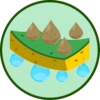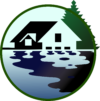Ecosystem services
Numbers corresponds with numbers on the board
What are ecosystem services?
1.
Ecosystem services – an idea closely related to the economy and the concept of natural capital. They are usually defined as the contribution of natural ecosystems to broadly understood human well-being. Ecosystem services can be understood as an income from natural capital. The idea was created to “translate” the message of natural sciences into the language of economics, which is to serve as a contribution to preserving the natural environment in a state as stable as possible.
Researchers involved in the economic analysis of ecosystems distinguish four categories: production services, regulatory services, living space services, cultural and scientific services.
 | 2. Production of goods, i.e. food, raw materials, soil fertility and nutrient cycle control, pollination, species’ habitats. |
 | 3. Water protection against pollution, reducing the effects of extreme weather phenomena (i.e. floods). |
 | 4. Protection against fires – reduction of gas emissions and damage caused by fires, maintenance of species’ habitats. |
 | 5. Climate protection through carbon storage, participation in the gas cycle i.e. carbon dioxide, oxygen, methane. |
 | 6. Soil formation, erosion prevention, protection against the effects of extreme water levels. Soil is also the habitat for a number of species. |
 | 7. Possibilities for recreation and tourism, aesthetic stimuli, an inspiration for culture, art, spiritual experiences, scientific data related to climate, vegetation, and human civilization. |
Did you know that …?
8.

Reduction of pollution in waters flowing from surrounding fields and flowing through peatlands to the river can reach 60-100%!
9.

It has been estimated that in Biebrza valley peatlands 10.4 million m3 of water is retained annually, which corresponds to a service worth EUR 5.5 million.
10.

A 30% share of peatlands in the catchment area may cause a reduction of a flood wave within 60-80% (by delaying the outflow speed they cause the flood wave to flatten).
11.

On 1m2 of mire you can find several thousand individuals representing several orders and dozens of species of invertebrate.
12.

Travertine (derived from calcium carbonate precipitation on alkaline fens) is a building material for many Roman buildings, e.g. the Colosseum, the facade of the Basilica of St. Peter, Bernini’s colonnade in front of this basilica and also, for example, the facade of the Romanesque basilica Sacré-Coeur in Paris.













